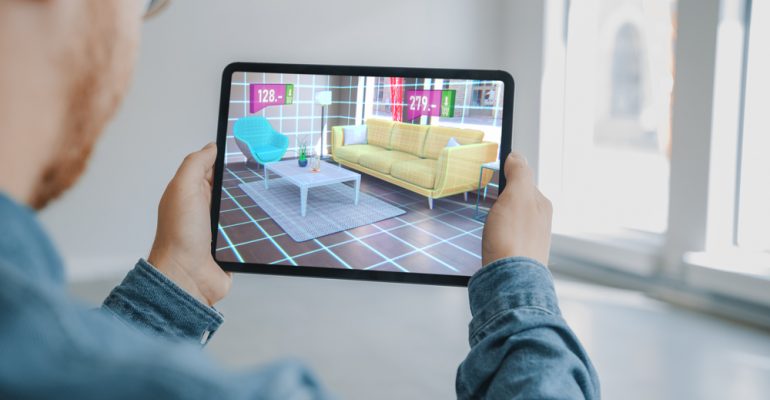
How AR and VR are Helping Ecommerce Industry in 2022

How AR and VR are Helping Ecommerce Industry in 2022
The digitalization of millions of businesses and the rise of new online buyers began since few years. This trend persisted in 2021 and is expected to continue in 2022. This technological innovation has an impact practically on every business, and people of all ages are now familiar with the phrases Augmented Reality and Virtual Reality.
Despite the fact that Augmented Reality and Virtual Reality have been around for a while, they have lately gained traction in the business world.
If you’re planning to open an eCommerce business in 2022, adopting VR or AR will offer you a competitive advantage. These technologies can entice potential clients to buy from you and help you differentiate yourself from your competitors.
Do you want to learn more about how VR and AR can be used in the eCommerce world? In this post, we’ll look at the two technologies and how you might use them in your brand-new eCommerce business.
How AR Helping the e-commerce Industry
Customers want AR to be included in their purchasing experience. According to a poll of over 1,000 consumers, 61 percent of buyers prefer to purchase at establishments that provide AR feature. Furthermore, if a business offered AR, 71% of customers would purchase there more frequently. That’s an average of two-thirds of buyers saying firms they want AR! so much so that 40% of those polled indicated they’d be prepared to pay extra for a product they could try out using Augmented Reality.
Because there is a growing need for AR, more online retail companies and other e-commerce sites are turning to it.
Benefits of AR
Improves conversion rates:
Improved conversion rates are one of the most notable advantages of augmented reality in e-commerce. If users have a clearer image of the product they are going to buy, they are more likely to convert. The use of AR in e-commerce allows store owners to provide a more immersive and engaging product experience, which leads to higher conversion rates.
Personalizes Online Purchasing:
Augmented reality in e-commerce can help customers have a more personalized shopping experience. Customers will discover tools that allow them to see how items appear on them, show what sizes might fit them, or illustrate the real size of a product in their area, as well as other features that address the issues with online buying. Instead of seeing mannequins wearing the items in an online store, clients could view themselves in all of the ensembles to evaluate which one would look best on them. As a result, the amount of personalization is likely to boost the online shop’s conversion rates while also raising sales.
Reduces Return Rates:
According to research, a large proportion of customers have returned things they had purchased owing to defective or damaged goods. Another group of customers returned the merchandise because it did not match the description on the website. As a result, AR in e-commerce can reduce return rates by allowing buyers to select the best product for their requirements.
How VR Helping Ecommerce Industry
Today, VR acts as a link between the actual and virtual world, and it is rapidly changing the e-commerce industry’s future. By creating a virtual scenario of an actual shopping store for a buyer, VR is taking online shopping and e-commerce to the next level. VR’s immersive experience, paired with the touch and feel component, has completely transformed customers’ perceptions of online buying.
Benefits of VR
- Customers may desire to buy more purchases than they anticipated throughout their shopping trip.
- VR apps track consumer behavior. You may use this information to better your sales process.
- VR technology lets businesses avoid the high costs of opening a physical location.
- In comparison to internet purchasing, users may make better decisions. It’s easy to find the best thing when you can virtually try it on. As a result, a company’s returns may reduce while customer satisfaction rises.
- Retailers eliminate insecure and costly goods transportation from producers. They don’t have to wait for delivery with VR. They may select a virtual presentation of the product, examine it closely, and make a choice.
Success Stories in e-commerce with VR and AR
According to a Gartner poll, over half of shops want to invest in AR & VR. While many people have yet to make VR and AR a reality, many others have already done so. Many successful AR and VR implementations in e-commerce enterprises have already been documented. We’ve chosen a few examples to help you think about digital transformation and innovation.
The IKEA
IKEA offers a mobile application that uses AR to show consumers if a seat will fit in their space. All goods are displayed at scale in the app to give clients a sense of the objects’ true proportions. Users may also select numerous products and arrange them in a room at the same time to ensure that they complement one other.
Sephora’s app
The AR enabled Sephora app was built to allow users to visually test cosmetics. The program first scans a person’s face to determine where the eyes, mouth, and nose are located. Users may then experiment with different appearances, such as lip colors and lash styles, to determine if the makeup suits them.
The Dior VR Store
Visitors to Dior’s VR store may virtually peruse the brand’s soaps, lotions, and other goods and purchase them online. These VR retail experiences have aided the company in adjusting to COVID-19 pandemic lockdowns.
Final thoughts
It’s difficult to picture the e-commerce industry’s future without VR & AR. Although these technologies have yet to gain widespread adoption among online retailers, this is anticipated to change in the near future and we at Sapizon Technologies, are here to make your dreams a reality.
Contact us today to explore how we can help you grow your eCommerce business with AR & VR.